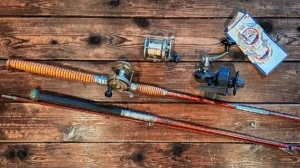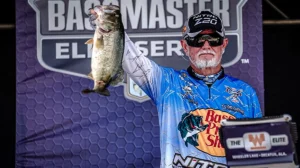Pro bass angler Justin Lucas demonstrates why and how to tie a loop knot when fishing straight-tail plastics for bass. Fishing straight-tail plastics has exploded partly due to the wide adoption of forward-facing sonar; when used together, the two take sharp-shooting and trigging pressured bass to a whole new level, as Jeff “Gussy” Gustafson proved during the 2023 Bassmaster Classic with his “moping” technique. When using the Damiki rig technique, Lucas emphasizes how a loop knot can increase your catch rate through improved bait action and orientation.
TACKLE USED (retail links)
- PLASTIC – Berkley PowerBait Jerk Shad (5-inch), color – Smoking Shad: Buy at Bass Pro Shops, Buy at Tackle Warehouse
- STAIGHT TAIL PLASTICS – Buy at Bass Pro Shops, Buy at Tackle Warehouse
- JIG – Berkley Fusion19 Swimbait Jig Heads: Buy at Bass Pro Shops, Buy at Tackle Warehouse
- LINE – Berkley Trilene 100% Fluorocarbon Line, 12-pound: Buy at Bass Pro Shops, Buy at Tackle Warehouse
THE SUBTLETY OF STRAIGHT BAITS
According to Lucas, paddle tail swimbaits seem less effective due to widespread use and intense fishing pressure. Instead, bass often prefer straight baits’ subtle and natural action, especially when presented above their heads. Lucas’s recent experiences, including a successful trip targeting giant western smallmouth bass, underscore the effectiveness of this Damiki rig approach across various regions.
TYING THE PERFECT LOOP KNOT
While the list of best fishing knots is long, the core of Lucas’s advice revolves around the loop knot. This knot ensures the bait maintains a natural orientation in the water and allows for more free-flowing movement. Lucas provides a step-by-step guide on how to tie the loop knot, including starting with an overhand knot and wrapping the line six times before securing it. Lucas explains that this method prevents the knot from shifting around the hook’s eye, ensuring the bait swims in a straight, natural path – crucial for long casts.
ADVANTAGES OF THE LOOP KNOT IN ACTION
The loop knot’s benefits are particularly evident when used with forward-facing sonar, where precision and bait presentation are paramount. By adopting the loop knot, anglers can avoid common issues like the bait swimming off-course or handing at an unnatural angle (usually vertically), thus increasing the likelihood of attracting and triggering bass.












